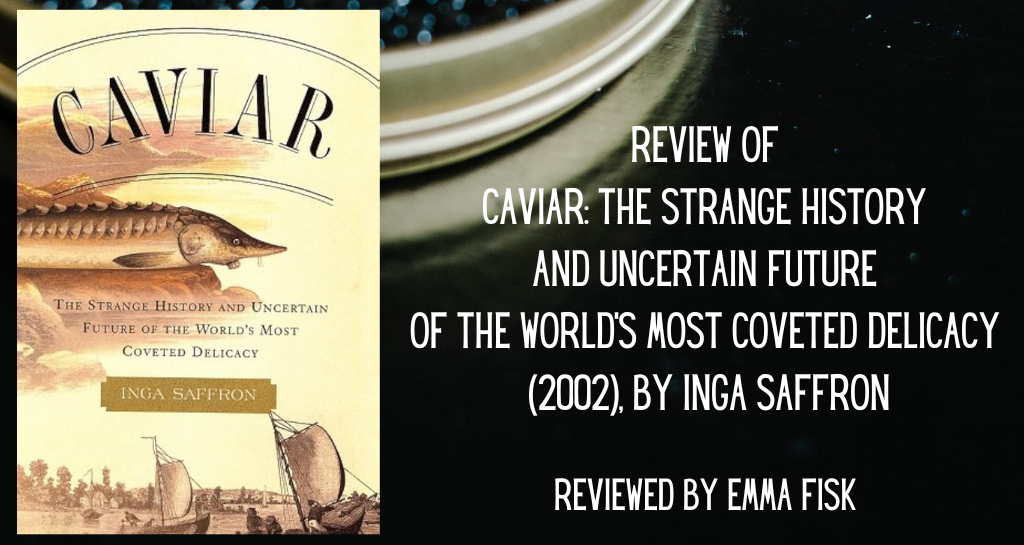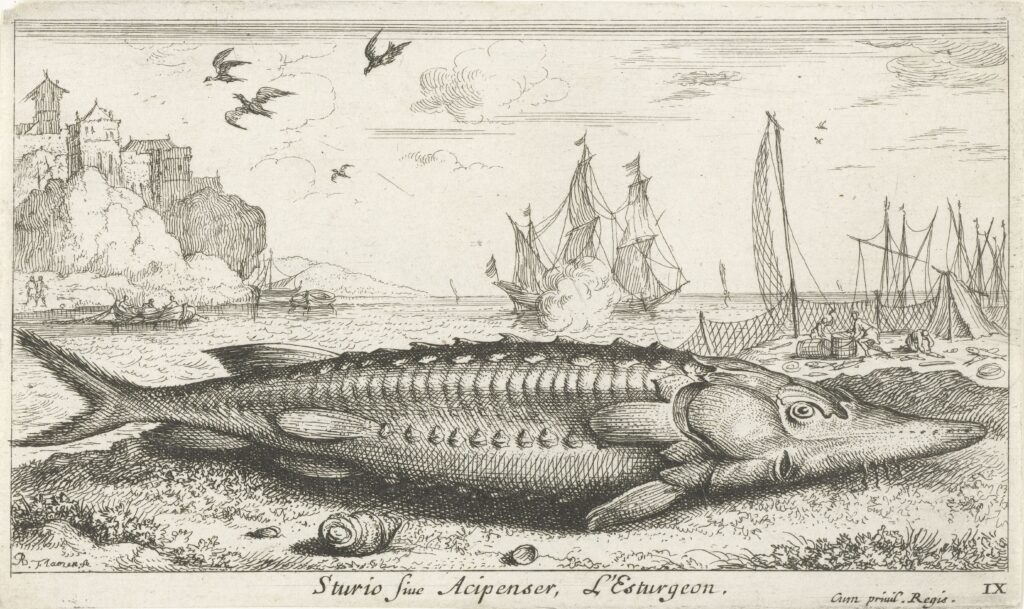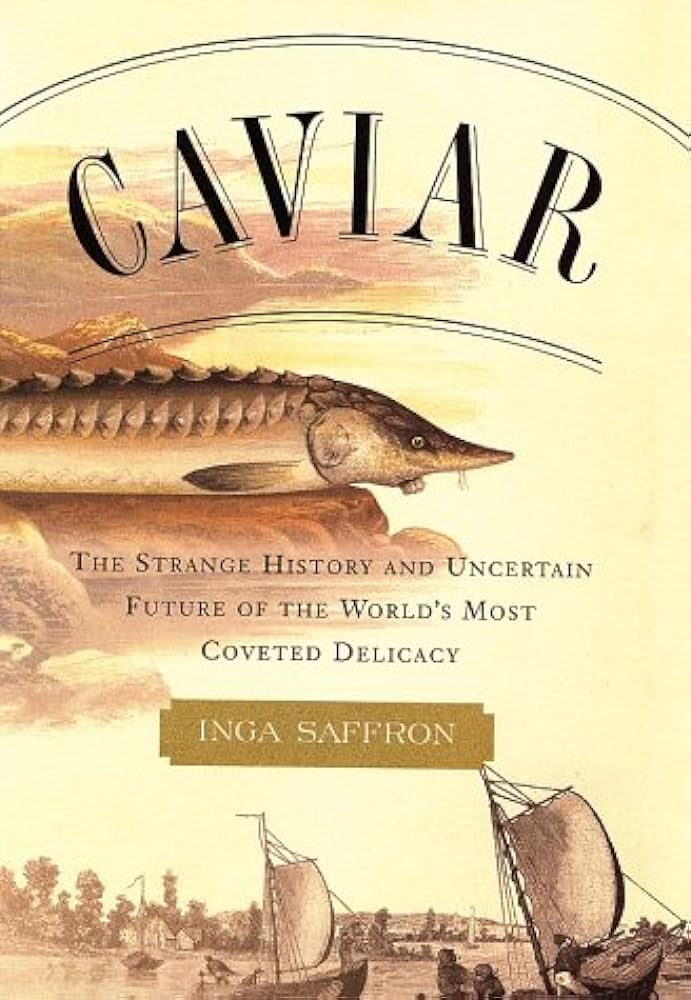
Inga Saffron’s Caviar presents a well-rounded history with deep insight into the lives of various parties involved in caviar production, trade, and regulation. The book beautifully details the volatile caviar industry, painting a picture of a world where the sturgeon no longer jumps freely in the waters of the Volga River—or anywhere, for that matter.
Caviar, or the eggs of a mature female sturgeon, has impacted history in unexpected ways, shaping a new cultural and natural landscape while also leading to a tragedy of the commons in global waters. According to Saffron, the democratization of access to luxury goods has transformed the food of the tsars into a highly desired middle-class delicacy, all the while creating intense strains on sturgeon populations.

Caviar explores three distinct processes: (1) the rise of caviar to the forefront of the public mind, (2) the rush to capitalize on this newfound popularity, and (3) the post-Soviet destabilization of the caviar market. Saffron writes that sturgeon eggs were long approached with caution, considered a backward dish enjoyed in the five nations surrounding the Caspian, and discarded for the pigs anywhere else. Caviar was widely appreciated in the Russian Empire for religious reasons, and travelers who indulged in it at its freshest attempted to bring delicacy to the Italians, Greeks, and Ottomans. The perishability of caviar made it challenging to trade in until the invention of refrigeration and steam-powered ships rocketed it into a position of global prestige. Saffron writes that by 1820, “Caviar’s ephemeral nature and exorbitant price gave the food a status that appealed to the burgeoning bourgeoisie of Europe” (p. 77). With most Russian-produced caviar being shipped abroad, the price of caviar within Russia rose far beyond a working man’s budget.
Saffron then discusses the global race among nations to become caviar’s top producer. German, French, and American waters were quickly divided among competing companies eager to cash in on the growing market. Overfishing led to the near extinction of the American and European sturgeons as the next generation of fish was devoured on bread and blinis. The Soviet Union managed to maintain some control over sturgeon fishing by nationalizing caviar production, but even that wouldn’t last. Electric dam production and overfishing threatened to end the Russian caviar empire. Following the collapse of the Soviet Union, however, poachers and newly established private institutions flooded global markets with cheap caviar (p. 164). Since the 1990s, the global caviar market has been a battleground between conservationists and poachers, and a limited number of legitimate businesses are still allowed to fish in the waters and tributaries of the Caspian.

Source: Wikimedia Commons.
Saffron provides a highly persuasive argument, prompting a meaningful conversation about the place of caviar in the global commodity market. If one were to measure the impact of caviar on the global market in terms of consistent demand, reliable supply, and reliable transportation infrastructure, the caviar trade would seem to be in decline. Saffron reports that there are simply not enough wild sturgeon to “support the appetite of the whole world” (p. 264). Only around 1,800 mature sturgeon persist in the waters of the Volga River as of the writing of Saffron’s book.
Demand has grown substantially since the initial caviar explosion during the Industrial Revolution, leading to an imbalance exacerbated by heightened production restrictions. Today, the three species most associated with Caspian caviar production (beluga, Russian sturgeon, and stellate) have been classified under Appendix II endangerment and placed under international watch. With catch limits placed on the largest caviar producers, international importers like Gino International and Caviar & Caviar resorted to buying smuggled caviar to feed high demand. This illegally acquired caviar is often harvested before it is ripe, eliminating the interchangeability expected of a commodity. Transportation is also unreliable in the post-Soviet caviar market. The Convention on International Trade in Endangered Species (CITES) reports stopping hundreds of pounds of caviar per suitcase brought through international airports by smugglers in the 1990s. The future of legally produced caviar is left in the hands of experimental projects like the costly sturgeon breeding of Stolt Sea Farms.

Inga Saffron’s Caviar provides a charming yet chilling historical account of the challenges of sustaining a luxury commodity in a world where natural resources are under increasing pressure. Saffron focuses on modern culture as a driving force for the luxury goods market. Caviar was “appropriated as a delicacy by the wealthy” (p. 264). Intrigue fueled by the enigmatic Russian empire introduced caviar to the world as a food of “legend and tradition” (p. 164). This strange obsession has left the sturgeon in a compromised and uncertain position, deserving of Saffron’s title. The book is a rich historical account featuring several colorful interviews that read almost more like a work of investigative journalism than an academic publication. I greatly enjoyed Saffron’s writing and would recommend Caviar to readers looking for a captivating history of a well-loved delicacy or looking to engage in conversation surrounding the sustainability of the modern luxury market.
Emma Fisk is a sophomore in the College of Liberal Arts at the University of Texas at Austin, currently pursuing her B.A. in Government. She hopes to attend law school with a focus on intellectual property law.
The views and opinions expressed in this article or video are those of the individual author(s) or presenter(s) and do not necessarily reflect the policy or views of the editors at Not Even Past, the UT Department of History, the University of Texas at Austin, or the UT System Board of Regents. Not Even Past is an online public history magazine rather than a peer-reviewed academic journal. While we make efforts to ensure that factual information in articles was obtained from reliable sources, Not Even Past is not responsible for any errors or omissions.



